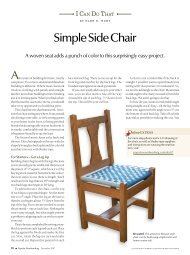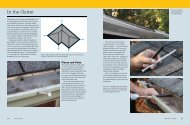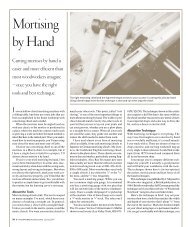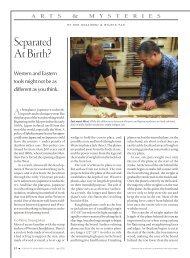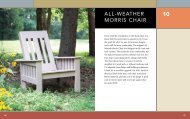Shaker Hanging Cabinet - Popular Woodworking Magazine
Shaker Hanging Cabinet - Popular Woodworking Magazine
Shaker Hanging Cabinet - Popular Woodworking Magazine
Create successful ePaper yourself
Turn your PDF publications into a flip-book with our unique Google optimized e-Paper software.
Making a Strong CaseOnce you select your boards and joint and planethem down to the correct thickness, you shouldmill all the parts for the carcase. Joint one longedge of each board, rip them to width and thencrosscut them to finished length. Leave the doorparts and frame stiles long for now – you will cutthem to fit the assembled carcase.The first joints to cut with this project are thethree rabbets in each side piece. Set up your tablesaw to cut a 3 ⁄ 4 "-wide x 1 ⁄ 4 "-deep rabbet using theinstructions provided in “Cut Accurate and CleanRabbets.” Make a test cut in some scrap that’s thesame thickness as your sides. Check your workwith a square and some care. If this joint does nothave a dead-on 90° corner, your carcase won’thave one either. If it is square, check the dimensionof the rabbet using a dial caliper. This mightsound like overkill, but it’s not. Here’s why: If thisjoint is just a little off, then all the joints that followit will have to compensate for this small error– especially when you start building the door andfitting it to the case. Small errors like this tend toadd up during the course of a project.When you’re satisfied with the setup of yourdado stack and rip fence, lock the height of thearbor. This is important for a couple of reasons.With some less-expensive table saws, you canactually force the arbor to creep downward duringa cut with a dado stack. I’ve seen it happen– your dado will look like a ramp for skateboardersinstead of a properly made joint. Also, youwill be keeping this exact height for the next twojoinery operations, so locking in your setting is agood idea. With your saw set, cut this rabbet onthe ends of the two side pieces. This joint holdsthe top and bottom of the case in place.Next, cut the rabbet in the sides that will holdthe back panel. To create this rabbet, you needonly adjust your rip fence to make a 1 ⁄ 2 "-wide x1 ⁄ 4 "-deep rabbet and cut that rabbet on the longback edge of each side piece.After that, cut the dados in the side pieces thatwill hold the two 1 ⁄ 2 "-thick shelves in place. Tomake your life easier, make sure you do not changethe height of the dado stack you just used to cut therabbets. Remove the dado stack from the arbor andinstall the correct number of wings, chippers andshims to produce a perfect 1 ⁄ 2 "-wide dado.The dados for the shelves are 1 ⁄ 4 " deep. Byleaving the height of the blades alone, you ensurethat the shelves, top and bottom will keep yourcase square. If you change the height of the bladeseven a tiny bit before cutting the dados, one of twobad things will happen. If your cut is too deep,your shelves won’t seat all the way down intothe bottoms of the dados without some extraordinaryclamping pressure. (If you manage toclose this joint, your carcase will end up with anhourglass shape and the rabbets at the top andbottom will be gappy and weak.) If your dado cutis too shallow, the shelves will cause the sides tobulge out in the center and the rabbets at the top andbottom will be gappy, unattractive and weak.To make the dados in the sides, use your tablesaw’s miter gauge (set to 90°) and a gauge blockclamped to your rip fence, as shown in the photobelow. Mark on your side pieces the locations ofboth dados. Sure, it will take an extra minute,but it prevents mistakes. Also mark the top andbottom of each of the sides so you don’t get theright and left sides confused – a common mistakethat even professionals make.With the dados cut, you are almost ready toassemble the basic carcase. It’s always a goodidea to prepare your interior surfaces for fi n-ishing before assembly. Finish-sand the insidefaces of your pieces (start with #100-grit paperand work up to #220), or plane and scrape thesurfaces to your liking.Test the fit of the joints and clamp the casetogether without any glue. Do not skip this step.A rehearsal is worthwhile for several reasons:You’ll figure out exactly how many clamps youneed so you don’t have to go rushing across theroom for more as the glue sets up. You’ll also figureout the best procedure for clamping the casewithout your parts flopping around. And you’llmake sure your rabbets and dados fit soundly.As you make this milk run, make sure youkeep the front edges of the top, bottom and shelvesperfectly flush with the front edge of the sidepieces. The top, bottom and shelves, if you haven’tnoticed, are 1 ⁄ 2 " narrower than the sides.Before you take the clamps off, pay particularattention to the squareness of the case. Measurethe case from corner to corner and compare thetwo dimensions. If they’re the same, everything’ssquare. If they’re not, put a clamp across the twoThe gauge block, which is clamped to the ripfence, sets the location of the dado on the sidepieces. But because the gauge block sits in front ofthe saw blade, there’s no danger of trapping yourside piece between the rip fence and the bladeI recommend using a dado stack for cuttingrabbets because it requires only one setup. Thefeatherboard makes the operation safer and moreaccurate by keeping your work pressed firmlyagainst the saw’s table.corners that produced the longer measurement andapply the tiniest bit of clamping pressure. Comparethe corner-to-corner measurements again.Repeat until everything is perfect. I like to checkthe squareness now because the cabinet usuallybehaves the same once you add the glue.Now add glue in your rabbets and dados. Ifyou are new to woodworking, I recommend aslow-setting glue for casework. There are severalvarieties, the most common being TitebondExtend. The glue’s extra “open time,” which iswhen the glue is wet and your parts can moveMiter gaugeGaugeblockRipfencewhile making this cut – a major source of kickback.If you have a stock miter gauge, this would be anexcellent time to add a piece of adhesive sandpaper(I prefer #100-grit) to its smooth metal face toimprove grip during this operation.woodworking-magazine.com ■ 17




